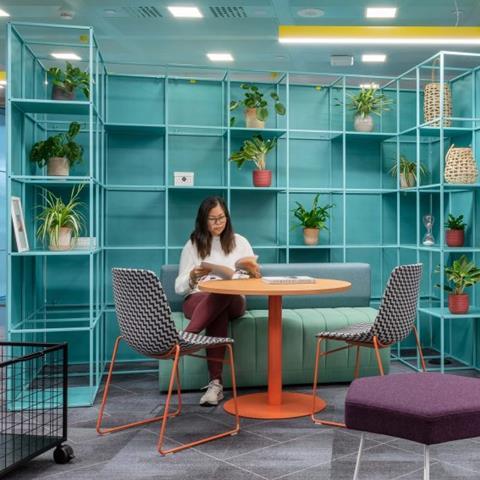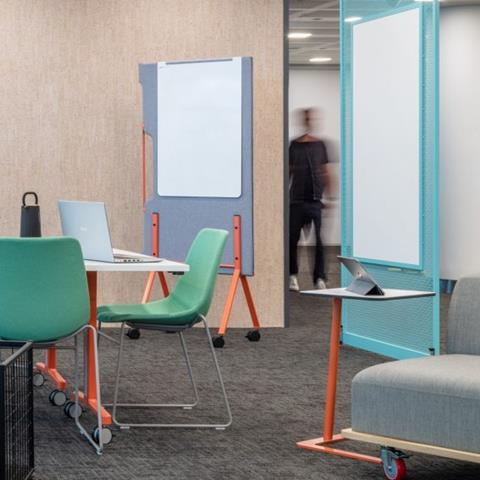Designers should see it as a responsibility to reuse what is already there - including furniture, says Simon Bird, director at LOM architecture and design

In some ways, the shift in understanding and tone around the retrofit conversation has been extraordinary. It is great to see architects, clients and investors looking seriously at what they can save and reuse when upgrading and developing buildings. But often the conversation is purely focused on building structures – steel, glass, brick and concrete that have high carbon footprints, and should be preserved and reimagined where possible. But we shouldn’t stop there – change needs to be holistic and we need to consider all finishes and materials that go inside buildings.
The average piece of furniture generates around 47 kilograms of carbon footprint – equivalent to burning 5.3 gallons of petrol, about a third of a normal tank. Now think about all the chairs, desks, filing cabinets and dividers in an office of several hundred people – and the fact that in many office refits, it all ends up in a skip. This is particularly true for the many interiors and furnishings that make use of composite materials, which are inherently difficult to recycle. Creative reuse offers an alternative. Interesting, bespoke, and eye-catching new items built from redundant furnishings.
As designers, we should see it as a responsibility and a challenge to transform what already exists to fit new ways of working. At LOM, we recently undertook a large scale creative reuse project for a major financial institution. The 11 floors of its 1980s HQ needed to be completely reimagined, with the objectives of boosting the amount of usable space, enhancing the working environment, helping the building improve its sustainability credentials, and extending its lifespan.

A specific and central objective of this project was to reuse as much of the existing contents as possible – hundreds of desks, chairs and other furnishings that were no longer needed as the older ‘rows of desks’ model transformed to a more modern, vibrant, collaborative office format.
Like the move away from fast fashion – this shouldn’t be about ‘thrift’. Mass consumption is a drain on our resources, especially when products are produced that are difficult or impossible to recycle efficiently. This should be an exciting opportunity for designers to get creative – delivering new function and aesthetics in reuse.
In our project, what had been desktops became focus booths, collaboration tables and colourful whiteboards. Handles filed spaces where computer wires had once snaked. Wooden bases were transformed into flexible storage, and high level ‘tool rails’, remodelled, re-finished, and recoloured to be almost unrecognisable.

We need to advocate a non-disposable culture. To save items destined for landfill. This starts with how we think about refits – and that in turn starts with us as designers. If we can succeed in not making something look reused, but tailor-made, then we can succeed in bringing this into the mainstream, and reducing mass disposal without compromising on the end result.
Thinking about creative reuse does also go beyond fixtures and fittings, to rethinking underutilised building space on the whole, and in doing so limiting any need for a building’s footprint to be expanded. On this same project, the 1980s building had a lot of underutilised space with the potential to do more. The structure had a large atrium which was ripe for the addition of dramatic suspended pods housing meeting rooms. Similarly, inefficient ground floor space was rejigged and easily made space for a new conference centre. At the heart of the building, award-winning flexible workspace has now replaced rows of desks – better for staff wellbeing and productivity.

Creative reuse is not something we have all the answers to yet. However we should all be jumping at the opportunity to learn and improve by doing. The more we make the cases to our clients, and the more we produce incredible new spaces with minimal waste, the better we will become at identifying previously unexplored opportunities to make more of our materials and buildings.
Change does not have to mean waste. Redundancy should not have to mean disposal. We need to harness our creative power as an industry to reimagine what we have. To ‘be more Lego’ if you like. Our clients, the users of our spaces, and our planet will thank us for it.

Postscript
Simon Bird is a director at LOM, a Shoreditch-based architecture and interior design practice which has expertise in retrofit projects
















1 Readers' comment